Pre-read
The word omnichannel is not new to today’s world. Industries like retail, consumer-packed goods, and even finance have been meeting customer expectations and differentiating themselves by designing around the customer experience. The health science industry is in the early stages, only beginning to explore modernizing communications and touchpoints with a user-centered approach for omnichannel engagement. This is not to say it hasn’t been wanted: 80% of life sciences professionals agree that a significant investment is expected toward improving customer interactions, and 75% say they need a more agile method to consolidate insights across channels (Exeevo, 2021). The industry has been waiting.
In this red paper, we will explore the fundamentals of omnichannel and provide insight for how to actively begin implementing this approach today with your team. Discover how your projects can directly benefit by exploring some real-world examples of this approach in action. At Red Nucleus, we remain at the forefront of understanding and executing the latest development and communication strategies to build future-proofed tools and experiences. We have drawn from our own expertise within the space as well as cross-industry research and best practices to develop a life sciences-relevant guide to omnichannel that will position any initiative for success.
A Rapidly Changing Landscape
The global pandemic accelerated nearly a decade of communication, education, and scientific evolution in only a few months. For the health sciences and life sciences industry, this shift has been felt 10-fold given its notoriously slow history to embrace digitally driven solutions.
Seemingly overnight, the industry underwent a digital transformation, shifting legacy communication methods such as in-person meetings, peer-to-peer sessions, and congress events to virtual for the first time ever. From video conferencing ad boards with break-out rooms to virtual congress booths and landing pages, a multichannel virtual approach allowed these companies to continue working despite lockdowns and travel bans.
These global changes, brought on by the pandemic and accelerated by technological advancement, are having a ripple effect on the field team and HCP experience that needs to be addressed with speed and agility to keep employees and customers satisfied.
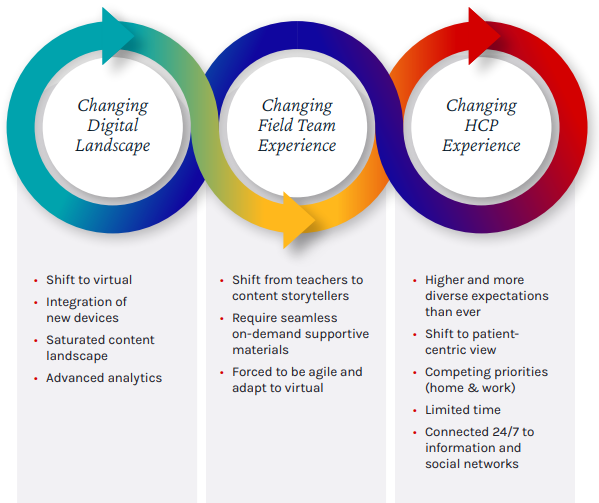
Now that the initial dust from the switch to virtual has settled, it’s more critical than ever that medical affairs and commercial teams pause from reacting and become proactive for the future by creating an omnichannel experience.
The Omnichannel Shift
Building with an omnichannel approach is not a new concept as we have seen in the retail and quick-service food industries; however, it is in the early stages of being used within pharma. Learning from these industries on the frontier of omnichannel, life sciences has a unique opportunity to take the successful strategies, and adapt them to fit the wants, needs, and goals of the field team and HCPs.
Now is the time to capitalize on the pace of the life sciences industry and introduce an omnichannel approach to deliver a one-of-a-kind, seamless user experience across multiple touch points.
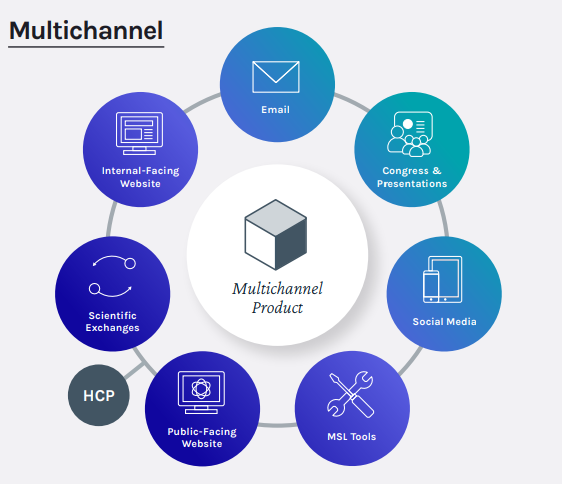
A multichannel experience focuses on the information and disseminating the same information across multiple channels at the same time.
The first step in the process is truly understanding what omnichannel is and how it differs from multichannel.
According to Harvard Business Review, 9 out of 10 consumers want an omnichannel experience with seamless service between communication methods
Omnichannel focuses on providing a seamless customer experience. Channels work together in harmony to immerse consumers in a highly personalized experience. By breaking down the walls between channels, HCPs and field teams are empowered to interact with a company in ways that feel natural to them.
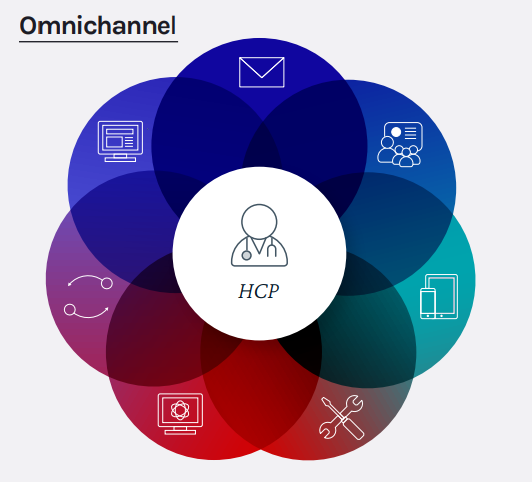
An omnichannel experience focuses on the user and their journey, placing them at the center of decision making and determining which information is best for which channel and when.
The result of a successfully implemented omnichannel experience should feel seamless for HCPs, as they move from channel to channel without realizing their own movement through your field team pipeline.
Planning for Hybrid With Omnichannel
The COVID-19 pandemic has reshaped the world and will have a lasting effect on what warrants an in-person meeting or travel, creating an exciting opportunity to build a new and better communication model. According to a March 2020 FirstWord pharma survey, “physicians appear to be relatively unconcerned that their awareness, knowledge and use of the most novel therapeutics in their area of disease specialty will be adversely impacted by any temporary reduction in face-to-face meetings with pharmaceutical and medtech industry representatives.” These data suggest that the reprioritization of in-person engagement and the rise of hybrid models with strong digital detailing are here to stay. Building a hybrid model today, so it is ready for when in-person events return, can position your organization for even greater success.
Understanding how people’s preferences, goals, and challenges change as this landscape rapidly evolves has a direct impact on which tactics will be most successful. Simply creating tools and experiences based off of historic success will not be enough to thrive tomorrow.
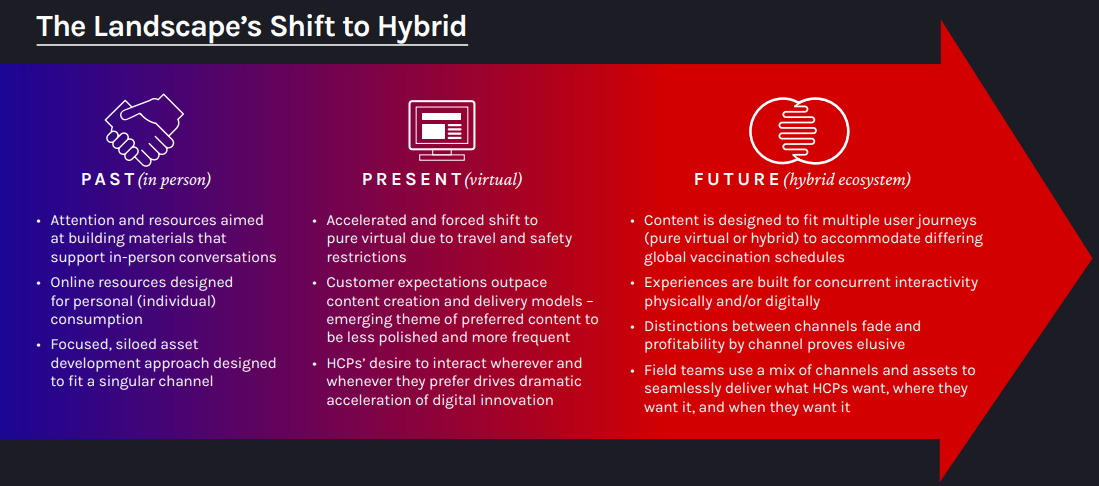
The Value of Omnichannel
Building an omnichannel ecosystem can be a competitive differentiator and improve return on investments (ROIs) while giving HCPs the information they want, how they want it, and when they want it. We have also observed firsthand the production efficiencies and ROI optimization benefits of omnichannel due to its measurable and modular structure.
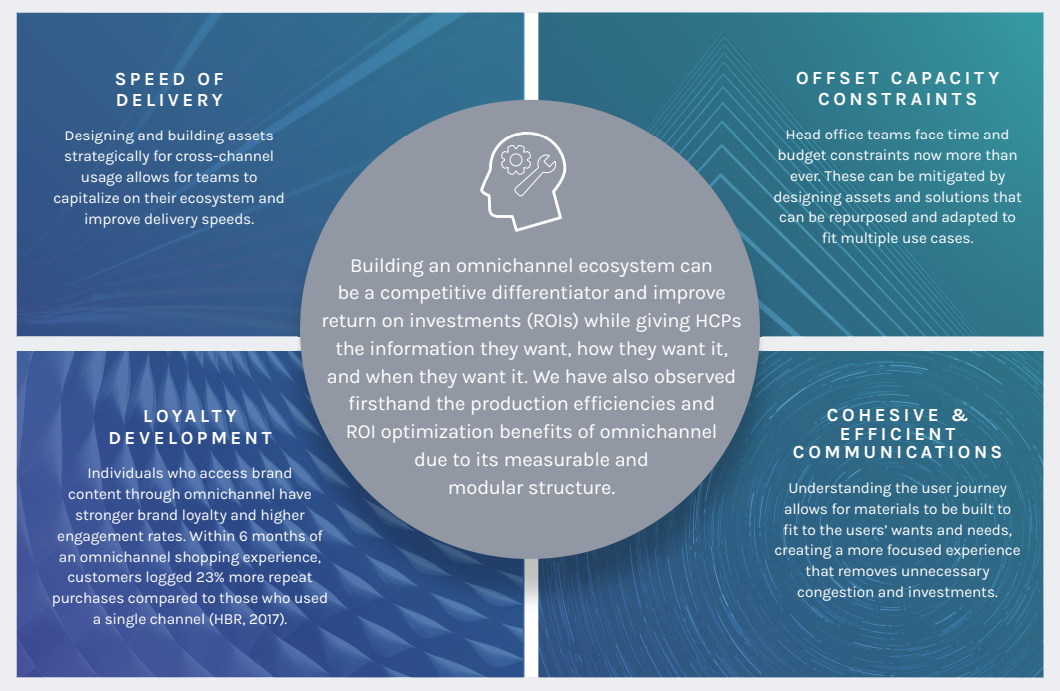
The Red Nucleus Omnichannel Approach
As we mentioned earlier, an omnichannel approach involves integrating each touchpoint to deliver exactly what your user needs, when they need it, and across multiple channels. This ask sounds simple enough, but it has proven to be a challenge if proper planning and strategy are not taken into account. Although linear in nature, with each step building upon the last, having an omnichannel-educated team allows for all steps to be considered and planned for throughout the process.
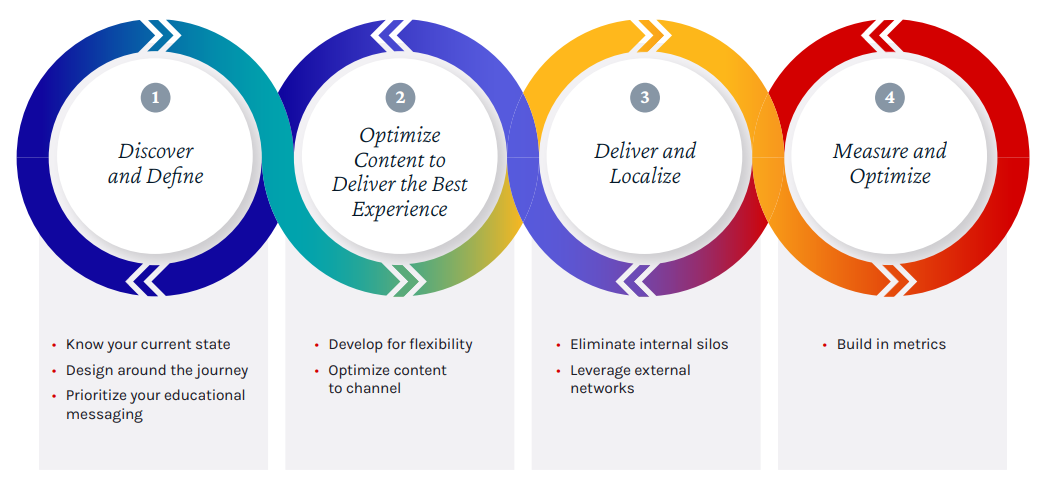
Define your current state
Performing a preliminary content audit identifies what assets you have, what they communicate, and how they are performing to discover opportunities for improvement and gaps that exist along the user’s journey.
Map user journey and design around it
Creating a seamless end-to-end user experience comes from understanding the field team and HCP journey. Unlocking this step before developing solutions helps you build a better understanding of who they are and what their needs and wants are.
Identify and prioritize messaging platforms & educational objectives
Choose which communication and education objectives to focus on: the consistent thread that is pulled through each touchpoint, measured for success against a metric for understanding and knowledge retention.
2. Optimize Content
Develop with a modular asset approach
Be prepared to embrace change by employing an asset library-driven approach. Developing omnichannel assets that work across different technologies provides longevity to investment and greater ROI.
Optimize content per channel
Understand how your users interact with each channel and design accordingly. Selecting the proper length, key message, visuals, and voice are key to launching content that is successful and achieves the greatest engagement.
3. Deliver & Localize
Eliminate internal silos
Support omnichannel thinking internally. When internal teams that span communication types and initiatives are aligned, they are more competitive and informed. 73% of MSLs say they are seeing more openness from commercial colleagues to collaborate with medical affairs (Exeevo, 2021).
Leverage external networks
Establish partnerships with channel providers and content builders with omnichannel experience. A network of organizations with partnerships will outperform single firms with creativity and expertise.
4. Measure & Optimize
Build in metrics
Identify from the onset key metrics to evaluate success and build in the collection of these analytics (+ more) to any digital asset. Use analytics to measure the impact of new customer journeys and assets; then improve upon and enhance them based on accurate feedback and impact.
Assessing and evaluating these analytics informs content enhancement decisions and reveals any changes in the customer journey.
Modular Asset Development and Omnichannel Approach
Omnichannel development is a fully integrated approach built around flexible components and assets that are channel agnostic. This approach allows for near plug-and-play development, meaning an asset such as a 3D model can be repurposed and re-used across multiple channels with minimal re-work, such as augmented reality (AR) tablet apps, public-facing websites, social media posts, or virtual reality (VR) conference experiences.
Omnichannel development revolves around identifying the different touchpoints along the field team and HCP journey, and aligning development decisions with each of these in mind to find efficiencies across content creation.
CASE STUDY: Omnichannel in MS
Our client has led the way in building innovative and engaging tactics for multiple sclerosis (MS) disease education in medical affairs, creating one-of-a-kind learning moments from congress booth installations to digital field tools.
Each tactic worked toward elevating the audience’s understanding of MS and unmet needs existing within the disease to build confidence around diagnosis and disease progression management. The challenge our client began to run into was determining how their existing tactics worked together, and what channels (third-party and owned) were missing to make the education campaign as impactful as possible to their respective audience types, in addition to addressing the added challenges caused by a global pandemic.
Key Challenges:
Aligning the proper educational message for different HCPs along their familiarity spectrum Adapting existing channels to virtual channels Remaining as best-in-class example for delivering innovative educational experiences
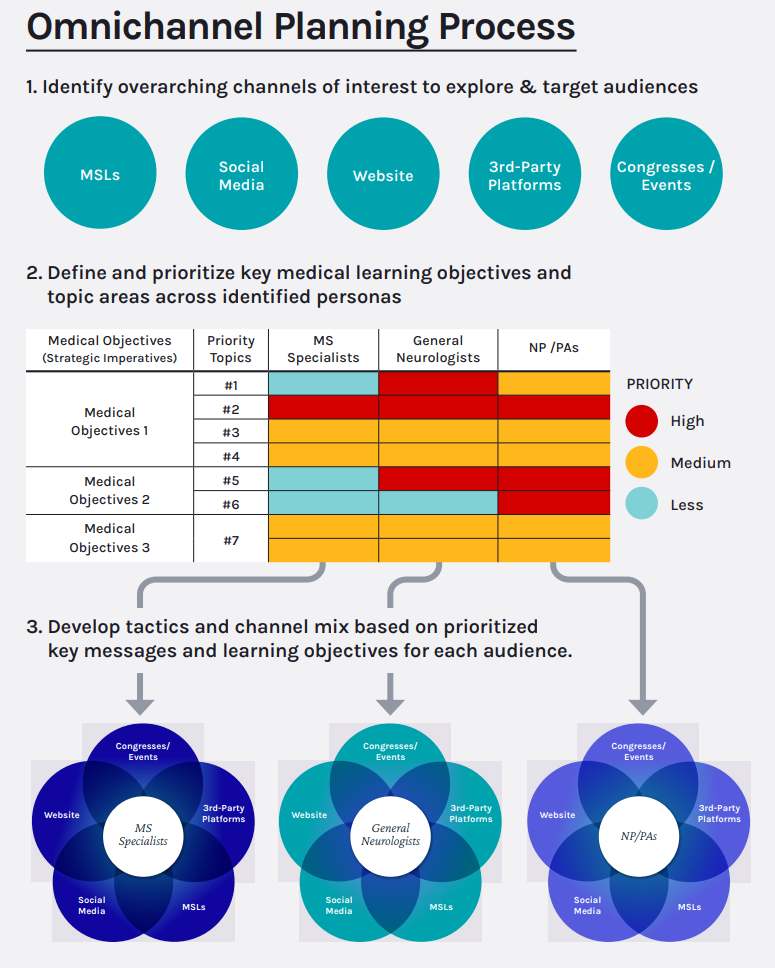
We worked with our client to take an omnichannel approach to their MS portfolio – pivoting from a tactic-centric mindset to a user-centric one while working with multiple internal stakeholder groups. This approach ultimately would support an accelerated knowledge transfer, avoid educational gaps and repetition, optimize target audience engagement, and generate behavior change among HCPs.
The team began with discovery and definition, defining the target audiences (general neurologists, specialists, and NP/PAs), identifying the channels of greatest impact across audience groups, and defining what success would look like. From here, broad key message areas were defined across the audiences, and then further tailored to fit into unique narratives specific to each audience and mapped appropriately.
With the audiences and respective key messaging and learning objectives defined, the team then began defining the optimal channel mix for each audience– ultimately defining each tactic. Each audience’s messaging plan was tailored to their needs and user journey, while ensuring no silos were created between to ensure efficiencies of scale across and consistent analytics reporting per audience was maintained. This collaborative and strategic approach resulted in a tailored user experience and all medical affairs initiatives being integrated in a seamless manner, driving toward established KPIs.
Finalized educational tactics worked together to create a cohesive experience for users, simultaneously relaying concise targeted messages while connecting to each other, encouraging physicians to continue exploring and providing an easy-to-navigate experience to support MSL discussions.
Collective Channel Mix Tactic List:
Website – The core tactic of the experience, providing audience tailored content including videos, audio, and interactive experiences, available and sharable within one website.
Virtual Congress – Integrated and adapted content integrated into a variety of virtual congress and event sites aligned to the audience’s priorities and relevant topics to be showcased at each congress.
Established HCP Third-Party Platforms – A wide range of publications and posts fitted to accommodate existing platform structure, while disseminating key messages to the targeted audience across each outlet. Platforms: Sermo, ReachMD, RNSights, Figure1, Medscape, and M3.
Social Media – Medically relevant and visually captivating content with a robust editorial calendar around key events with an integrated, well-defined hashtag strategy and links to online tactics.
Medical Science Liaisons (MSLs) – Mindfully adapted core messaging and assets to complement MSL use as a conversation support resource, bolstering communications and HCP relationships.
Key Performance Indicator (KPI) and Analytics – Built-in analytics tracking and reporting across all tactics (site-specific user metrics, traffic sources, user flows, social media campaign metrics, asset/content engagement).
References
Bloomreach. What is omnichannel commerce? Definition, benefits and trends. Published online 2019. https://www.bloomreach.com/en/blog/2019/07/omnichannel-commerce-for-business.html
Exeevo. Executive Summary - Post-COVID pharma report. Published online 2021. https://content.exeevo.com/post-covidpharma-report-summary#/18
Gupta A. Omnichannel marketing: what can healthcare industry learn from e-commerce? Published online February 17, 2021. http://docplexus-insights.com/blog/omnichannel-marketing-healthcare-industry/
King, S. Physician Views: FirstWord poll finds nearly half of all physicians anticipate a ‘greater than moderate’ impact on patient care as a result of the COVID-19 outbreak. Published online March 11, 2020. https://www.firstwordpharma.com/node/1707417
Mantsios O. The healthcare industry: what is changing in omni-channel marketing, post-COVID? Published online January 30, 2021. https://customerthink.com/thehealthcare-industry-what-is-changing-inomni-channel-marketing-post-covid/
Research and Markets. Healthcare ecommerce market In North America, forecast to 2022. Published online March 2019. https://www.researchandmarkets.com/research/zk547s/healthcare?w=4
Sopadjieva E, Dholakia UM, Benjamin B. A study of 46,000 shoppers shows that omnichannel retailing works. Published online January 3, 2017. https://hbr.org/ 2017/01/a-study-of-46000-shoppers-shows-that-omnichannel-retailing-works
